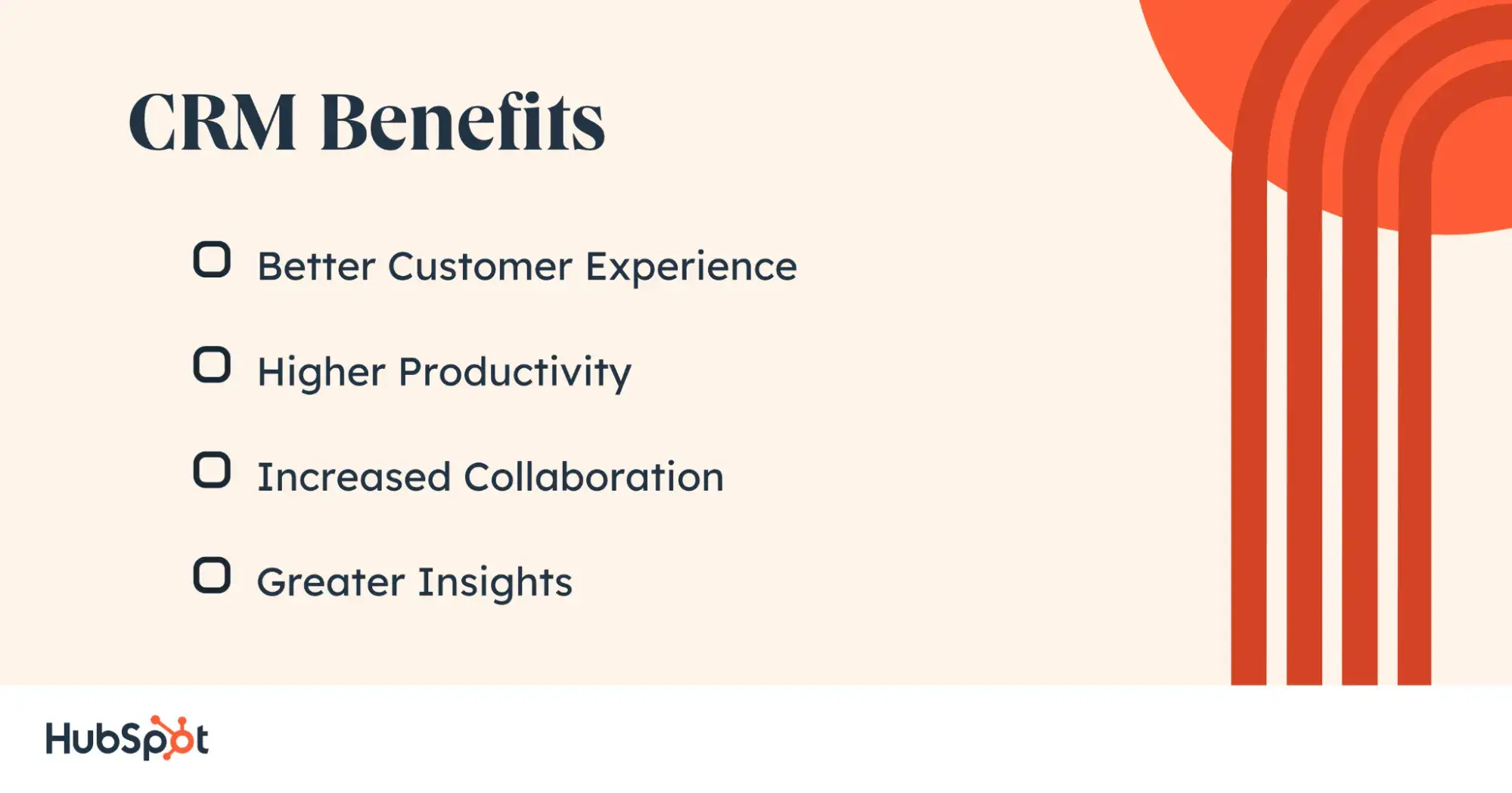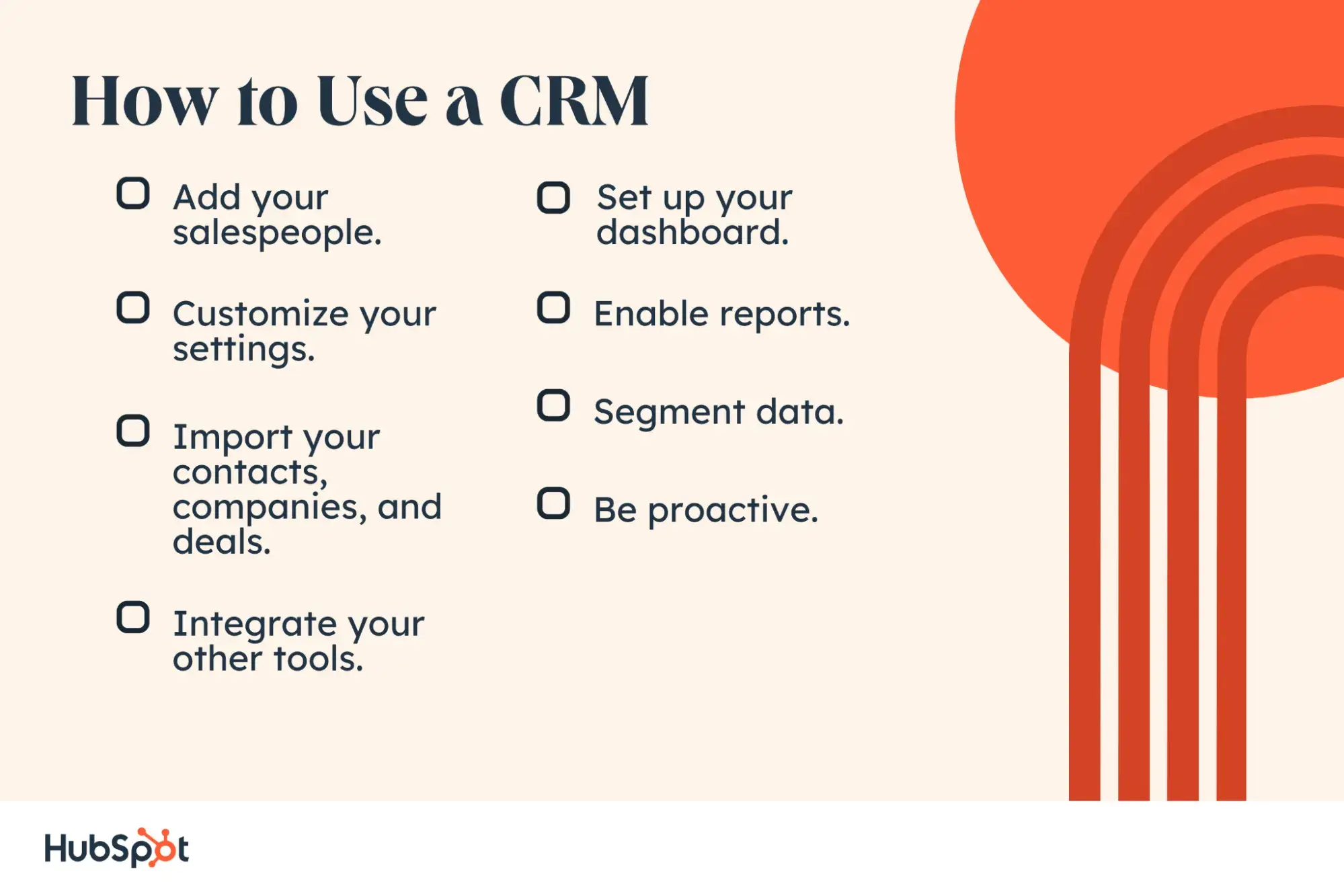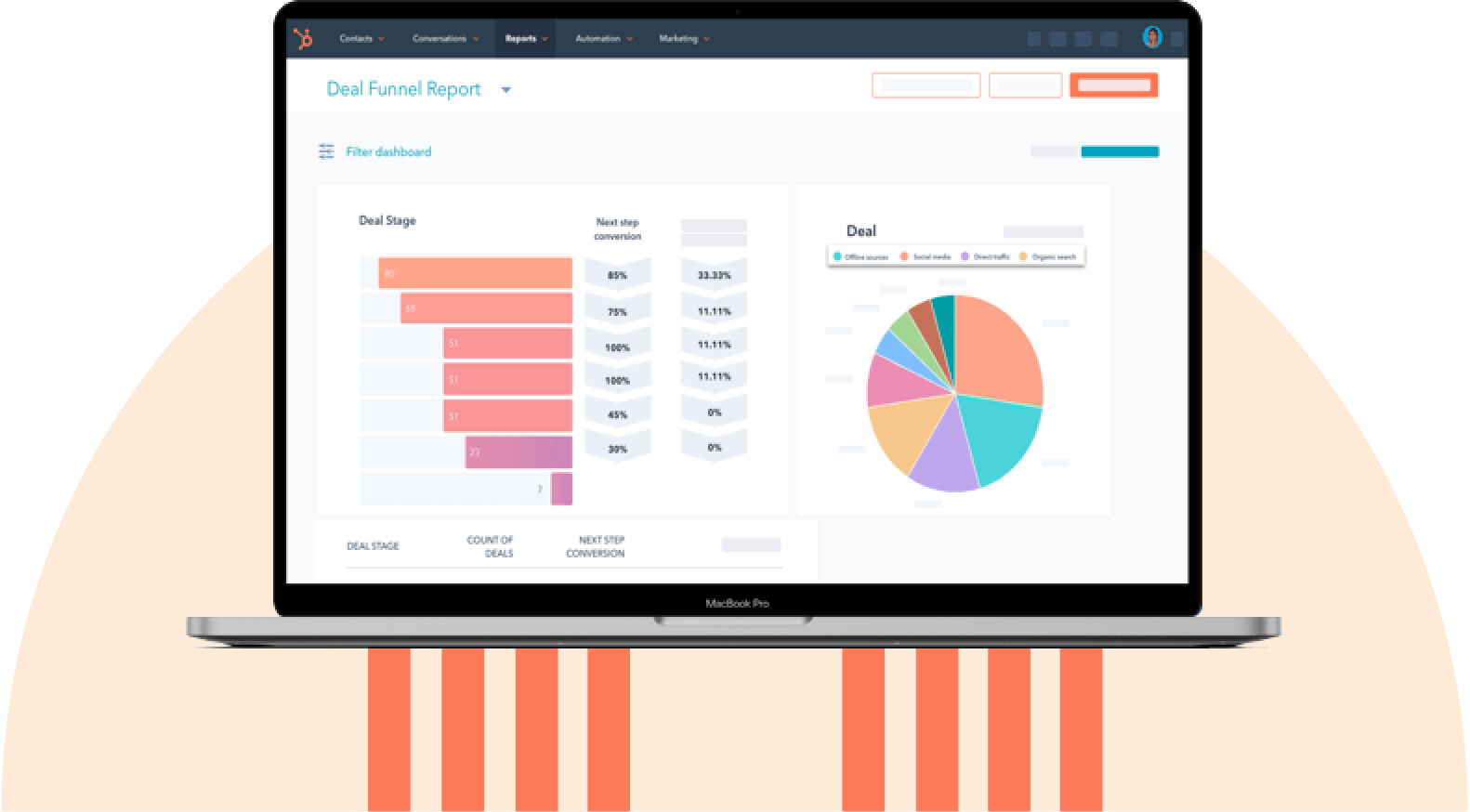Table of Contents
- What does CRM stand for?
- CRM Strategy
- Benefits of CRM
- CRM Terms to Know
- How to Use a CRM
- Your CRM Is the Key
What does CRM stand for?
CRM stands for “customer relationship management.” A company’s CRM stores all interactions with potential and existing customers — everything from someone’s first visit to your website and activity on your website to the exact time they opened your sales proposal and how long they looked at it.
How does a CRM work?
A CRM becomes the central hub of all your customers’ data. CRMs gather information from various sources such as websites, social media, emails, and phone calls. This data includes contact details, engagement history, orders, and the customers’ preferences.
You can add data manually, make edits, or add notes to customer accounts so your sales team has all the data at hand, in one centralized location, at any time.
There are four main advantages of using a CRM.
Benefits of CRM

1. Better Customer Experience
In my experience, it’s much easier to provide a positive buying experience when you know a lot about your prospect. Seeing at a single glance every blog post, email, and ebook they’ve opened and/or read, as well as key details like their company’s size, location, and vertical, gives you a major leg up.
You can personalize your messaging and provide more value from the start.
Most CRMs will allow you to write notes after meetings or comments. This qualitative data can be used to deepen connections with prospects. Scott Williamson, vice president of sales and engineering at R. Williamson & Associates, keeps their CRM regularly updated.
Williamson says, “I find the ability to make detailed notes after every call or meeting invaluable — it ensures I never miss a key detail about a client's needs or preferences.”
Williamson also leverages the CRM's automation capabilities to set reminders for follow-ups, ensuring no lead falls through the cracks.
“Ultimately, a CRM is an incredibly powerful tool for building trust and credibility with prospects by demonstrating your dedication to understanding their unique circumstances,” Williamson says.
2. Higher Productivity
With a CRM, you can automate tasks like call and activity logging, reporting, deal creation, and more.
The less time reps are spending on administrative work, the greater the number of hours they have to get in front of prospects. Your revenue will increase proportionally.
Nikita Baksheev, marketing manager at Ronas IT, allows the CRM to do a lot of the administration. Baksheev has successfully handed over routine tasks like data entry, follow-up emails, and scheduling. The benefit, Baksheev says, is “freeing up our sales reps to focus on relationships and closing deals.”
3. Increased Collaboration
A sales manager can instantly see how and when her salespeople are reaching out to and following up with buyers. An account executive (AE) can quickly fill himself in on an opportunity his sales development rep (SDR) has prospected and qualified for him.
Salespeople on the same team can learn more about each other’s best practices and pinch-hit for each other whenever someone goes on vacation or gets sick.
Essentially, a CRM boosts rep collaboration and efficiency.
Pro tip: Check out HubSpot’s sales software!
4. Greater Insights
Stop wondering how your salespeople are doing. A CRM will give you a high-level and on-the-ground picture of rep performance, including team-wide and individual conversion rates by deal stage, average deal size, and deal velocity — and that’s just scratching the surface.
Imagine what you could do with this data-backed understanding of what’s working and what could be improved.
Tristan Harris, Demand Generation Senior Marketing Manager at Thrive Digital Marketing Agency, uses a CRM to identify bottlenecks in the sales process. Harris says, “We use the CRM to analyze pipeline velocity and identify bottlenecks in our sales process, allowing us to refine our approach and improve overall efficiency continuously.”
CRM Terms to Know
Before we dive into the nuts and bolts of using a CRM, I’ll introduce you to several key terms you should be familiar with.
Contact
A contact is an individual person. Most CRMs will record their first and last name and email address. You can also keep track of details like their job title, company name, and annual company revenue — the possibilities are nearly endless.
Lead
A lead has indicated an interest in your product. They might be a Marketing Qualified Lead (MQL), meaning they’ve somehow interacted with your marketing content (for instance, downloaded an ebook), or a Sales Qualified Lead (SQL), meaning your reps have identified them as a good fit.
Deal
Also known as an opportunity, a deal is a potential sale. A deal should move through the various stages of your sales process.
Link contacts to deals. If you’re working with CMO Jane Doe and Marketing Director John Smith on a single purchase, they should both be associated with that deal record.
Company
If you’re selling to businesses, you also want to keep track of which contacts and deals are linked to which organizations. The typical CRM puts the “company” record at the top of the hierarchy.
For example, you might associate ten different contacts and three different deals with a single company.
Source
Your leads come from various sources, including trade shows, referrals, forms on your website, webinar attendees, etc. Tracking conversions by source and deals won by source lets you hone in on your most effective prospecting channels.
Activity
Any action by your salespeople or prospects typically falls under the activity umbrella, including calls, emails, voicemails, demos, a new contact record, an updated field, etc.
Deal Stage
Each step in your sales process should be represented by a deal stage. To give you an idea, your reps probably have an exploratory call with almost 100% of the prospects who buy.
So, “exploratory call” might be the first deal stage in your CRM.
Pipeline
Deal stages are organized into pipelines. Every salesperson should have their own pipeline in the CRM so they can track which opportunities are currently in progress.
As a deal gets closer to the close, it should move from the left to the right.
CRM Strategy
A CRM strategy is how a company plans to use its CRM to grow its business and delight its customers. Generally, organizations will establish a CRM strategy before they start to use it.
Essentially, a CRM strategy keeps your organization focused on its goals. As I defined above, there are a lot of valuable tools and features that make up a CRM. But just because they‘re available doesn’t mean they should be put to use just yet.
Many businesses stop using CRMs because they get overwhelmed. It's understandable but avoidable — if you create a CRM strategy upfront.
First, I suggest you chat with your team to understand your goals. Sure, you want to better manage your customer relationships, but how? Why? What specific customer behaviors and interactions mean the most to your business? Jot these down, as they will dictate how you'll fashion your CRM settings and reports.
Secondly, define your ideal customer(s), perhaps in the form of buyer personas. This information is not only valuable to Marketing and Sales, but it will also help you understand what types of customers should be added to your CRM down the line — and what types you shouldn't add.
Lastly, map your customer journey. How do your customers typically “meet” your business? On average, how many touchpoints do customers need before they subscribe to your newsletter, become customers, and return for more? As your customer base grows and buyer personas split off into more detailed profiles, this customer journey will start to vary. Your CRM can help you keep track of that.
Now, let's dig into how to use your CRM.
How to Use a CRM
How you use and develop your CRM will largely depend on your needs. It’s important to evaluate the CRM options; then, when you find one you like, it’s time to put it to work.

1. Add your salespeople.
I’ve found the sooner you can get all the reps on your team using your CRM, the more comprehensive and accurate your data will be.
That’s why the very first step in a CRM implementation should be adding users. But make sure you’ve explained the value of a CRM — specifically, how it will help your salespeople bring in more business — and get their buy-in. If reps aren’t sold on the CRM, adoption will be extremely low.
(I recommend recruiting one of your top salespeople to act as an advocate. If he or she successfully uses the CRM, peers will naturally follow suit.)
2. Customize your settings.
Your CRM should reflect your sales process. That means it accurately maps the stages a customer goes through, from “lead” to “opportunity” to “customer.”
Of course, that requires knowing those stages in the first place. If you have no idea what your sales process looks like, I recommend taking several weeks to observe and measure the way prospects buy your product or service.
What differentiates those who buy from those who opt for a competitor — or make no decision? How long does it take from initial contact with a salesperson to a signed agreement, and what are the discrete steps in between?
Let’s say your sales process is divided into “Connect,” “Qualify,” “Demo,” and “Close.” Create deal stages in your CRM pipeline for each one. Now, you’ve standardized the sales process for your reps.
Next, create custom properties to store your data. Your CRM will have default “properties” or fill-in-the-blank details about your prospect. For example, HubSpot CRM comes with fields for phone number, email address, create date (the day they entered your system), city, and so on.
Most businesses have unique properties they want to track. To give you an idea, maybe you want to add a field for “Billing ID,” “Time zone,” “Product purchased,” or “Global office address.” Create those custom properties now before you import any existing data to your customizable CRM.
Finally, if you’re using a currency different from your CRM’s pre-set currency, adjust that as well.
3. Import your contacts, companies, and deals.
Chances are, you’re currently using a different CRM or spreadsheet to track your prospects and opportunities.
Almost every CRM lets you import this information by uploading a CSV file. Each column in your spreadsheet should match a contact property in the CRM, so your data will flow seamlessly between your old and new systems.
When importing contracts and details, you’ll know to include the obvious (names, job roles, company, emails, and so on), but you may not think to add personal details about the customers, particularly against individual people.
You can use our CRM to deepen relationships by manually adding personalized information such as customer preferences.
Thomas Medlin, co-founder at JumpMD, says, “The main benefit of using a CRM has been the ability to improve customer relationships.”
According to Medlin, having a centralized database of customer information makes it easy to quickly access customer history, preferences, and past interactions. This enables teams to provide personalized service and anticipate their needs more effectively.
“I've found that this personalized approach not only increases customer satisfaction but also enhances loyalty and retention. By leveraging the CRM to its fullest, I can build stronger, more meaningful connections with my clients,” Medlin says.
4. Integrate your other tools.
Marketing, sales, and customer success information should be centralized in your CRM. This gives you a 360-view of your prospects and customers and cuts down on manual data entry.
Here’s an example of an inefficient process using several tools:
- Collect leads using a form builder.
- Put those leads into your email tool so Marketing can nurture them.
- Export qualified leads to your CRM.
Imagine this process if you’re using the HubSpot CRM with HubSpot Marketing and Sales. Leads who filled out a form, started a conversation with a rep via chat, or performed key actions on your site will be added to your CRM. If they’re highly qualified, they can be routed to a salesperson. If the lead needs more time, the marketing team can nurture them with educational content. The entire process is seamless — and far more efficient.
Not using HubSpot? I suggest picking tools that already integrate with your CRM of choice (check out your CRM’s integration partners) or connecting them using Zapier. For instance, you might set up a Zap so Google Form submissions are automatically transferred to your CRM.
Nikita Baksheev uses CRM integrations to help populate their CRM accurately. Baksheev says, “We use our CRM for advanced prospect profiling. Integrating CRM data with social media insights and third-party databases helps us create comprehensive profiles, crafting highly targeted proposals and pitches.”
5. Set up your dashboard.
You should have a crystal-clear overview of your team’s performance so you can keep them aligned and give the right coaching and direction. That’s why I’ve found a CRM dashboard so handy: It’s like a control panel that you can customize to fit your specific needs.
Choose which statistics appear on your dashboard based on your sales objectives and process. For instance, if your team is supposed to sell more of X product this month, you might want to see a breakdown of units of X product sold versus Y product. Or, if you set activity metrics for your reps, you may want to have a section for the day’s “completed activities.”
Phil Strazzulla, founder of SelectSoftware Reviews, credits his CRM with the team’s ability to make data-driven decisions. The CRM provides analytics and reporting features that offer insights into customer behavior, sales trends, and campaign effectiveness.
Strazzulla says, “By analyzing data, [the sales team] can make informed decisions about where to focus our efforts and how to adjust our strategies. This analytical approach helps us optimize our marketing and sales initiatives, ensuring better outcomes. The ability to leverage data in real-time has been instrumental in driving our business growth.”
6. Enable reports.
As a sales manager, you’re spending a lot of time looking at data. But your reps should be spending as much time as possible selling. That’s why I think it’s a great idea to create daily, weekly, monthly, and/or quarterly email reports.
For instance, reps at HubSpot receive a stack ranking each morning via email showing how each member of the team is doing that month in terms of new business, upsell and cross-sell revenue, and net revenue. This daily digest encourages friendly competition and gives salespeople an incentive to keep working even after they’ve hit quota.
Consider sending out an email for activities added and/or completed by the rep, emails sent and/or received by the rep, calls made by the rep, deals won by the rep (displayed by count or value), and/or retention rate by the rep.
7. Segment data.
Once your data is loaded into your CRM, you can get smart with it. User and data segmentation means you can send targeted marketing campaigns. If you know exactly what your prospects are looking for and how you can serve them, then you can tailor marketing messages, drip campaigns, and offers to increase conversions.
Sergey Taver, marketing manager at Precision Watches, says, “I've used [segmentation] to run targeted email campaigns that have significantly higher open and conversion rates. The personalized approach not only engages customers more effectively but also drives better results for my marketing efforts.”
8. Be proactive.
Once you’re set up on your CRM, you’ve got an abundance of data that allows you to be proactive to your prospects’ needs.
Will Yang, head of growth and marketing at Instrumentl, advises proactively offering solutions based on historical data and recent activities.
Yang says, “This proactive stance not only delights customers but also preempts potential issues, fostering deeper trust and loyalty. With a CRM, you’re not just managing relationships; you’re nurturing them in a way that pays dividends in customer satisfaction and long-term business growth.”
Your CRM Is the Key
This guide only scratches the surface of what you can accomplish with a CRM. Insights from sales experts showed me how important a CRM is for gathering standard business data about prospects, as well as personal details about meeting calls or customer preferences. The more data you can add to the CRM, the better.
And the sooner you get started, the better — it’s really never too early to use a CRM.
Editor's note: This post was originally published in September 2017 and has been updated for comprehensiveness.
Using a CRM




.jpg)
